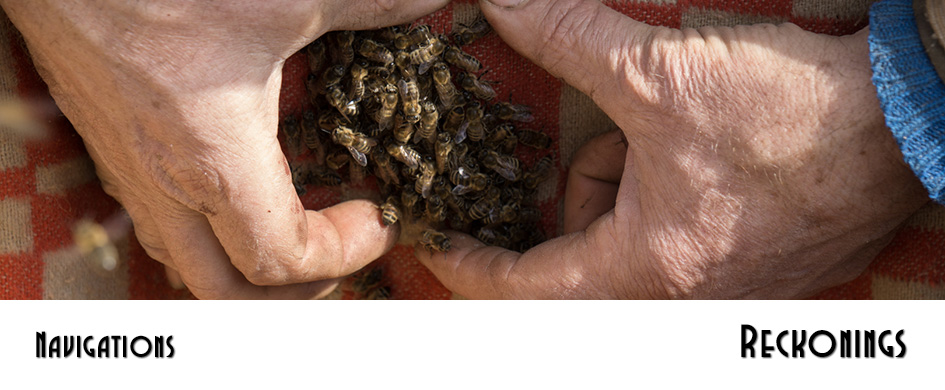“Prey” would soon replace “kin.” We were running out of time. My two girls, Nella and Sonia, watched transfixed on the terrarium where fifteen of the brothers and sisters remained. As a family, we gathered Bell jars and pho take-out containers to save them from themselves. Each private enclosure had an inch of woody substrate, a long stick, and lids made of pantyhose (generously donated by my wife). Inside lived the praying mantises who unexpectedly joined our quarantine as we rung in the pandemic new year.
I was out fishing a Susquehanna tributary, finding the first trout of the year when my waders began to buzz. Normally, I don’t take calls on the stream, but it was Marika, so I answered. Nella’s voice came through and she shouted, “Dad! Praying mantises! They’re everywhere! On our Christmas tree!” While I rushed to get home, Marika confirmed that indeed there were tiny praying mantises everywhere.
Their origin was clear. They had hatched on the tree. The next question that came to mind was, “How many?” In their voices, it sounded like thousands. Praying mantis fecundity is not exactly at my fingertips, but that number seemed reasonable, maybe even a low estimate.
I pulled into the driveway of a home that was quickly becoming familiar. We had moved in only two months before, just ahead of Thanksgiving. I hurried in the garage and up the steps. Marika and the girls were in stances that can only be described as containment. The mantises were spreading. They were leaving the tree. They were on the walls. On the curtains. On the ceiling. Ancient sages poised on the walls; forelegs questioningly raised. What next?
“Don’t just look! Get that tree out!” My fascination was broken by Marika’s voice. I had to get it out, but this winter day was well below freezing. Were we just going to kill them all? With the girls watching? Squish the ones on the walls and freeze the polite ones who waited on the tree? I rushed to the kitchen and got a plastic container meant for a salad or leftover cake. Sonia held it under the branches as I shook the tiny mantises into the plastic bowl.
A member of MantisHQ took one look at my photos of tiny green forms hanging upside down from a Douglas fir needle and told me we have Chinese mantis, Tenodera sinensis. They eat fruit flies. They should be kept humid. They are friendly little pets. When they reach the third instar, they become cannibalistic.
All told, we saved about forty. We set out to raise as many as we could, which led our family to regular rituals of shaking flightless fruit flies—astonishingly cute and pathetic creatures—into each enclosure for mealtimes. The mantis does not waste a single movement in its hunt. A silent predator, camouflage meets deadly speed to snatch prey in its forelegs. Ideally this is so. Our babies still flailed and fell from their panty hose perches as they chased flies. These creatures, known to scientists as Drosophilia melanogaster, are flightless through artificial selection. Just as dog breeders select for desirable traits, scientists prefer research subjects with the stubbiest wings. Now their flight apparatus is so underdeveloped they can only walk to the end of a stick, fruitlessly flap their wings, then turn around to try again another time. The praying mantis is a different form of life altogether. Its life cycle consists of eight to eleven stages or instars where the mantis molts its too tight carapace for the bigger one forming beneath. With so many growing mantises, keeping them full of fruit flies was a family affair.
All four of us would sit on the floor, and the girls would take out the chosen mantises who had earned names and fancier enclosures. Spaghetti, Meatball, Cappy, Cuppy, Bella, and, of course, Princess would gingerly step across our hands. Sometimes they would unexpectedly spring away, but most often they were docile. We would lock eyes, staring into their triangular faces and beckoning mandibles. At times they looked more like little machines than living beings. Others, they’d show humanlike verve snatching a morsel, taking a bite, then wiping their jaw.
As the winter waned and our familiarity with our mantises grew, we knew that soon they would become cannibalistic. We had separated out 12 mantises in individual containers, but 15 more remained in a single terrarium. It was hard to track their life stages as they all developed at quite different rates. One evening, I had just returned from the pet store with a new colony of fruit flies. The girls raced in first and as they peered in the glass, they both called out, “Coooooolll!” As I bent to look, I saw one mantis dangling in mid-air, suspended by its neck, which was grasped tightly by its sibling’s foreleg. The aggressor did not stop there. It was happily chewing the head of its own sister!
Marika and I wished to hide such brutality from our children, a feeling that had been exacerbated since our whole lives had been sealed in a container by Covid-19. Yet, we all accepted this fate with sadness and, admittedly, some fascination. At the least, we could save the rest from each other. We hurriedly ordered more take-out dinner to resupply our containers to protect them from themselves.
When June came, on Nella’s 9th birthday, we were ready to release our friends. Only five remained from the original 40, which sometimes felt like a solemn failure, but we remembered that nature herself is not so kind. This message was driven home on that last day, when we discovered Bella, our biggest, most beautiful mantis who had lived alone in the terrarium, on her back among the wood chips. Her passing felt different from the previous lost mantids many who had “mismolted,” emerging from their carapace deformed, unable to carry on. Others simply could not break loose.
Bella’s death was different, as it was she we had held the most and who we would show when family, friends, and colleagues asked about our unusual pets over Zoom. She never spent a day free to roam the world, but she had spent her last week outdoors. We had brought the enclosures to our patio so that the mantises could get acclimated to the weather and the natural cycles of night and day. Right before the release, life itself had been released from her. We buried her under the cherry tree that’s best for climbing.
We set free our remaining four in the four corners of our backyard. Amazingly, each of them found a critter to eat within minutes. At their size and maturity, our mantises had a massive advantage on many of the insects such as the firefly larva just then hatching. Of course, this would mean that they would be too advanced in life to find a mate born in time. Furthering their species was not the point. It just felt right that when they had grown and the season was warm enough, that they should be free to experience the world outside of the confines of artificial enclosure, despite the dangers of the wider world of sparrows, starlings, and robins.
Throughout the summer, vaccinated and mingling with the other creatures in our neighborhood, I couldn’t help but find an excuse to walk the perimeter of their backyards, eyes scanning the branches, hoping to lock onto an ancient sage in the brush who had taught us the virtue of biding our time.


